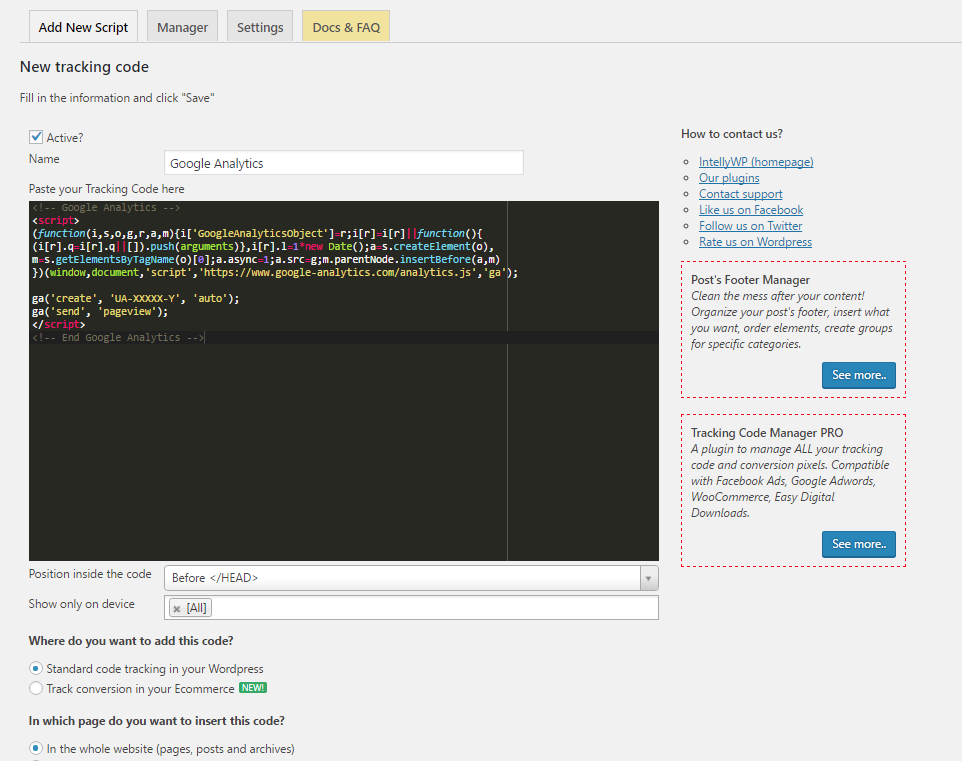The unlimited Internet
On March 30th, 2016, there were already at least 4.62 billion websites indexed. Yet 75% of these websites are not active but parked domain names only. (Quora, 2017). With over 1 billion active websites nowadays. It still can feel a little challenging to measure the impact of your own individual website.
Google Analytics tracking code
That is where Google Analytics comes in handy. It has become an industry standard. This fast, free and flexible digital analytics tool, provides insight in:
- how many people visit your website
- from which device
- and regions
Google Analytics is not the only digital analytics tool, but it is by far the best tool to measure web traffic. Hotjar is a good alternative but still less known. To use Google Analytics for your WordPress site, you need to install a “tracking code” to your website. So, the chosen digital analytics tool can access your website to collect statistics.
A tracking code is:
“a piece of JavaScript code, inserted in one or all your specific web page(s).”
Install Tracking Code Manager
Google Analytics? Hotjar? Which digital analytic tool to choose? Why choose if you can have both? In WordPress, you can add any functionality, without having to edit the source code. Use the plugin "Track Code Manager" in WordPress to install both tools. In this way, you can combine and deploy many tracking codes at once and find out yourself which tool suits you best!
The Tracking Code Manager is:
“a universal plug-in. It helps to put in an unlimited number of tracking codes from any digital analytics tool.”
![]()
How to install the Tracking Code Manager in WordPress?
This plugin can be to manage different digital analytic tools in WordPress at the same time. You can install it as follows:
- Login to your WordPress page with your login credentials.
- Go to menu, choose “Plugins” and “Installing Plugins”.
- Search the plugin “Tracking Code Manager”.
- Click on “Download” and after that on “Activate”.
- Go to “Settings” and choose “Tracking Code Manager menu” to put your tracking code in the plugin.
- Insert all tracking codes, you want to add for WordPress. Such as Google Analytics or Hotjar.
- Select the option “Position inside the code”.
- Then chose where to add this specific tracking code:
in the header or body of the HTML-page. - Click on “Save” to save the tracking code and start measuring.
TIP: You can display code on all pages or on specific pages and post.
Google Analytics WordPress
Install Google Analytics Pageviews in WordPress
Interested in the popularity of your WordPress web pages? Install “Google Analytics Page views” on your WordPress site. Over 50% of all websites worldwide use it to measure their web traffic:
- Register a Google Analytics Account.
- Copy the Google Analytics tracking code, at the end of the process.
- Login to your WordPress page with your login credentials.
- Go to menu, choose “Plugins” and “Installing Plugins”.
- Search the plugin “Google Analytics Pageviews”
- Click on “Download” and after that on “Activate”.
- Go to “Settings” and choose “Post Pageviews”.
- Insert the Google Analytics tracking code (API-token generated from Google Analytics).
- Within WordPress, choose “Posts” in the menu.
- Click on “Setting the displayed information” and select “Views”.
- Configure from the new “Post Page views Setting sub menu”.

Install Google Analytics Dashboard in WordPress
Do you want to see real-time statistics, inside your WordPress dashboard? The Google Analytics Dashboard for WordPress plugin is the right plugin. It enables you to track your WordPress website using Google Analytics tracking code:
- Number of visitors
- Acquisition channels
- Traffic sources details
The tracking code is customizable and allows advanced data collection.
How to setup Google Analytics Dashboard in WordPress?
Watch this video to setup Google Analytics Dashboard in WordPress:
After installation:
- Click the option “Set All information provided” in the upper right corner. Choose only the information you want to include in your reports to see.
- Click “Feed Google Analytics”
- Place the block as shown in the video. Move it anywhere on the Dashboard.
TIP: This article covered the most common ways to install Google Analytics for WordPress. You can find similar Google Analytics plugins within your WordPress Dashboard. Under Menu- Plugins- Search Plugin.
More information
- Download Google Analytics.
- Questions? Ask our Customer Service Department.
- No WordPress yet? Buy your WordPress package at ACTIVE 24.